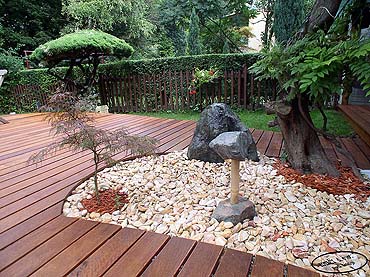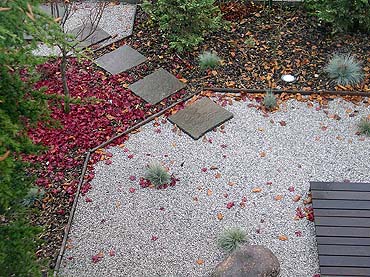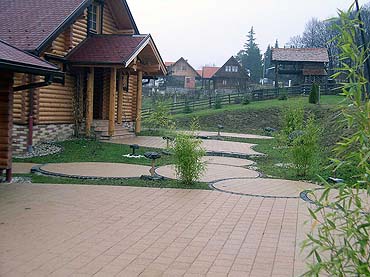

In the process of coming up with an idea of how to arrange a garden, it is important to intuitively experience the concrete space, and to position oneself mentally within the centre and look at it from inside, knowing well the form’s content and elements.
The goal of arranging a garden is to achieve harmony of the individual wholes and to maintain their balance. The harmony can be achieved by understanding and composing these three elements, which do not belong to the same area in the practical sense:
The sense of use can be determined by analysis of the content, whereas the content can be determined by the activities and the wishes of the individual users.

The content of an individual whole is determined by the wishes and activities of the individual user, e.g. barbequing, grass mowing, fruit tree pruning, growing of vegetables, having pets, meditating, planting flower pots, playing social games and sports, bathing, engaging in other various activities etc.
By choosing priority activities of an individual user, we are also able to obtain the elements of an individual whole, e.g. barbeque, pool, orchard.

We use the elements obtained to form a single individual whole, and instead of placing the elements within the space by grouping them, we intertwine them with the elements of other individual wholes, so that their form is achieved without the need for change of form of other individual wholes.
We repeat the process for the rest of the individual users, by taking care that we do not use elements which are subject to mutual interest, but those which appear once with every individual user. The elements which are not a product of not a single wish of the users, but are really necessary or have come about as the creator’s idea, are used as basic and free elements during the phase of space creation.
Building a carefully designed and quality made garden is done by highly trained horticulture and civil engineering professionals who have
accepted to do the job, or by true garden loving laypeople.

By using longer-lasting materials in their most natural form, the possibility of decline caused by weather conditions and aging is avoided. However it is not necessary that the garden building materials in every aspect be of the same characteristics as the ones found in nature, or simulate those. The arranged infield area is exposed to changing weather conditions, so the duration of the built garden will significantly depend on the water soaking properties of the materials used. By using carefully chosen materials the aspects of use and aesthetics are taken to a higher level.
The drawback of the building is presented by the fact that, unlike the aesthetics and the use, it has a determined life span. In that sense, a significantly greater effort would have to be made regarding the building works, so that the standard of the other two elements might be reached, all of which is supposed to bring into harmony.
The aesthetic details of the elements for this work are usually partially or entirely made ready for end use. By using elements, which have undergone certain more or less successful aesthetic procedures, in the right and moderate way, we can avoid the real danger of overusing those, thus keeping the balance, which itself is the ultimate goal of decorating.
In forming the aesthetic, elemental and in the same time the holistic part of the harmoniously arranged space, we are to use our feelings, and by no means our logic. The space has to affect each one of these three fields separately as well as their mutual relations.
Arranged gardens, yards or infields are spaces which are physical continuation of the human living space. The important difference between the space of the objects in which we live and that of a garden, is that a garden is biologically alive and physically dynamic, and, due to its nature, it is easier created and relatively easy corrected. Many users undertake partial or complete creation and correction independently. The result is always dynamic and there is no point at which we could stop and say that the arrangement of the space has finally finished. Due to aging and the user’s natural need for change, the garden is constantly under the pressure of correction and development.
By its positioning and its role the garden space extends directly into the interior we live in, yet due to its biological and design characteristics it is directly connected to the users’ lives, which is something I consider the basis of the understanding and the meaning of arranging the infield.

mirko.stijakovic@gmail.com